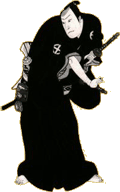Color List and Price Guide
View Swatches:
1-14a
14b-31b
34-52
53-74
75-93
94-103
Important Notes regarding Inro Cord · Footnotes
Thin Machine-Woven Japanese Cord (nylon, rayon, etc.) – Primary Group
• $8 per 5 foot length *
- See also #86. Dark Blue
Standard Thickness Machine-Woven Japanese Cord (rayon) – 1992 Crown Group
• $8 per 5 foot length *
Standard Thickness Hand-Woven Japanese Silk Cord **
• $60 per 5 foot length *
Other Standard Thickness Machine-Woven Japanese Cord
• $8 per 5 foot length *
Thin Machine-Woven Japanese Cord
• $8 per 5 foot length *
- See also #14a. Dark Purple, and #14b. Dark Black
Very Thin Machine-Woven Japanese Cord – NEW for 2001
• $8 for 5 foot length *
Important Notes regarding Inro Cord:
- Colors may vary slightly from dye lot to dye lot, especially in the hand-woven silk. Cord thickness may also vary slightly in each style. These are occasionally noted as a. and b. under the number.
- A variety of single lengths in other colors and thicknesses, as well as some longer and shorter pieces of some of the above cords, may be available from time to time.
- Longer lengths of some of the machine-woven cords (#14, #61, #86) may be available by special order.
- Please add $10 to each order for postage and packing.
Footnotes
For more information on tying the appropriate knots for inro and about the cord, read my publication: "The Inro Knot: A step by step illustrated guide to tying different knots for hanging medicine boxes". $5.


















